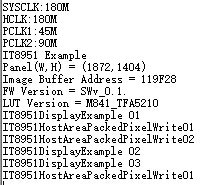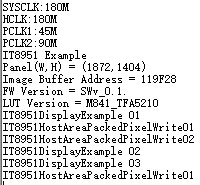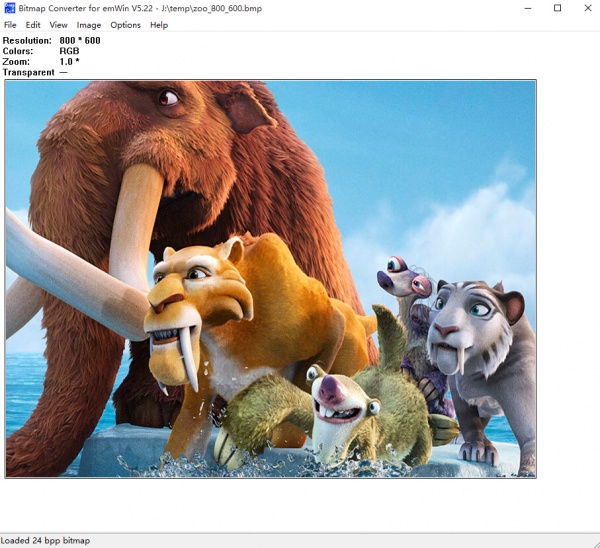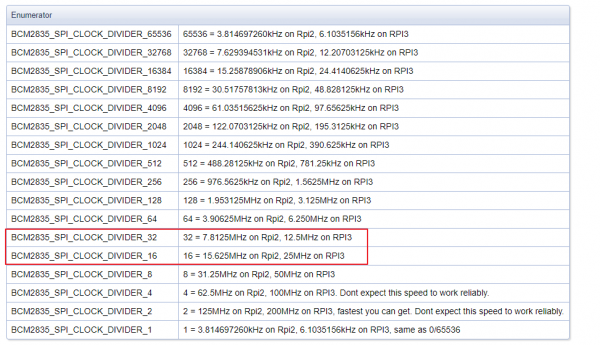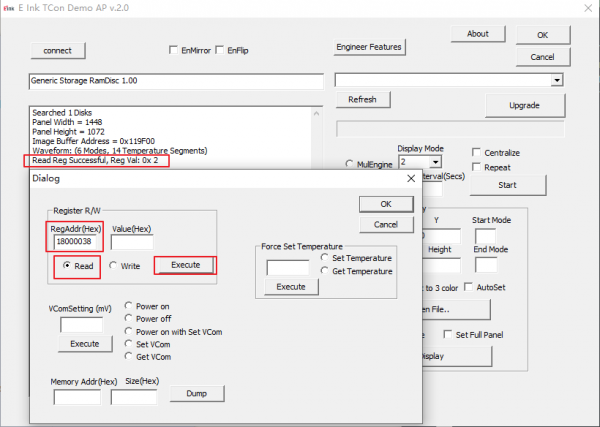10.3inch e-Paper HAT
| ||
Introduction
- 10.3inch EPD (Electronic Paper Display) HAT for Raspberry Pi, 1872 x 1404 resolution, 16 gray scale, USB/SPI/I80/I2C interface
- It has the advantages of low power consumption, wide viewing angle, and clear display under direct sunlight, and is often used in display applications such as shelf labels and industrial instruments.
- Note: As the screen of 10.3inch e-Paper is large, the glass panel and FPC are fragile. Hence, please be careful when use it for development. It is recommended to reinforce the FPC with scotch tape when developing. Please connect all the cables before powering the device, the device cannot support a hot plug.
- There are two versions: raw panel and HAT. Driver board (IT8951) is required for the raw panel, if you are the first time buying this product, we recommend you choose the HAT version which comes with the driver board.
| More |
Features
- No backlight, keeps displaying last content for a long time even when power down
- Low power consumption, basically power is only required for refreshing
- Compatible with Raspberry Pi Zero/Zero W/Zero WH/2B/3B/3B+
- USB/SPI/I80/I2C interface, for connecting with host boards like Raspberry Pi/Nucleo, etc.
- Comes with development resources and manual (examples for Raspberry Pi/STM32)
Specifications
- Operating voltage: 5V
- Interface: USB/SPI/I80/I2C
- Outline dimension: 216.70 × 174.40 × 0.78mm
- Display size: 209.66 × 157.25mm
- Dot pitch: 0.112 × 0.112mm
- Resolution: 1872 × 1404
- Display color: black, white
- Gray scale: 2-16 (1-4 bit)
- Full refresh time: 450ms
- Total refresh power: 1.2W(typ.)
- Total standby power: 0.1W(typ.)
- Viewing angle: >170°
Working principle
This product is an E-paper device adopting the image display technology of Microencapsulated Electrophoretic Display, MED. The initial approach is to create tiny spheres, in which the charged color pigments are suspending in the transparent oil and would move depending on the electronic charge. The E-paper screen display patterns by reflecting the ambient light, so it has no background light requirement. Under ambient light, the E-paper screen still has high visibility with a wide viewing angle of 180 degrees. It is the ideal choice for E-reading.(Note that the e-Paper cannot support updating directly under sunlight)
How to use
Working with Windows PC
- Connect display to IT8951 driver board as below
- Connect USB interface of IT8951 driver board to PC
- Download and open E-LINK-TCON-DEMO software
- Click connect as below
- Check option "AutoSet", then click "Open File" to open one picture for display. Browse diagram will be opened, and you should click "OK"
- Click "display" to refresh the picture
Working with Raspberry Pi
- Step 1: Insert IT8951 driver board to GPIO of Raspberry Pi, Connect e-Paper to driver board. You can also connecting by wires
| IT8951 Driver HAT | Raspberry Pi (BCM) | Description |
| 5V | 5V | 5V power input |
| GND | GND | Ground |
| MISO | P9 | MISO Pin of SPI |
| MOSI | P10 | MOSI Pin of SPI |
| SCK | P11 | SCK Pin of SPI |
| CS | P8 | Chip selection of SPI (Low active) |
| RST | P17 | Reset pin (Low active) |
| HRDY | P24 | Busy stats pin (Low when busy) |
- Step 2: Make sure you have switched to SPI mode
- Step 3: Download and install BCM2835 libraries to your Raspberry Pi
- You can also download the newest bcm2835 library from its official website http://www.airspayce.com/mikem/bcm2835/
- Copy the library you download to Raspberry Pi and install it withe commands below. You can also following the instruction on its website above
wget http://www.airspayce.com/mikem/bcm2835/bcm2835-1.60.tar.gz tar zxvf bcm2835-1.60.tar.gz cd bcm2835-1.60/ ./configure make sudo make check sudo make install
- Step 4: Enable SPI Interface of Pi
- Open a terminal and type the following command:
sudo raspi-config
- Choose Interfacing Options->P4->SPI->Yes
- Step 5: Compile and execute the program
Download and compile the program, and execute the following commands to download and compile:
Method 1: Download from our official website, it is recommended to use
sudo apt-get install p7zip-full sudo wget https://www.waveshare.net/w/upload/8/80/IT8951_20200319_Release.7z 7z x IT8951_20200319_Release.7z -O./IT8951 cd IT8951/ sudo make clean sudo make -j4
Method 2: download from github
git clone https://github.com/waveshare/IT8951-ePaper.git cd IT8951-ePaper/Raspberry sudo make clean sudo make -j4
- Check the VCOM value on the FPC
- Add the VCOM value as paramter and test the e-Paper
sudo ./epd -1.50 1
- Program execution phenomenon:
1) First, 16 grayscale bars are refreshed locally in sequence
2) Demonstrate examples of drawing lines, circles, rectangles, writing characters, and writing numbers
3) Demonstrate the examples of displaying bmp pictures in 1bp, 2bp, and 4bp modes respectively
4) Demonstrate the effect of fast refresh in A2 mode
5) Display a gif animation
6) Demonstrate a Demo that counts the frame rate
7) Finally, whiten the screen in Init mode for long-term storage in the warehouse
Working with STM32
Driver interface selection
- Drive by SPI mode (recommended), the advantage is that it occupies less pins, the drive mode is simple, and the communication speed can meet the needs of most scenarios.
- Adopt 180 mode drive (I80 interface is only considered when the SPI interface communication speed does not meet the application requirements), the advantage is that the drive mode is relatively simple, the communication speed is very fast, but it occupies a lot of pins.
- Adopt I2C driver (not recommended, the communication speed is very slow).
Driver board selection
Since IT8951 needs to occupy a relatively large RAM space, the general STM32 single-chip microcomputer can not directly satisfy it, and additional chips such as SDRAM are required for RAM expansion. For the test here, we use Open429I as the test board, and its onboard IS42S16400J (64-MBIT) SDRAM can fully meet the requirements of driving 10.3inch e- paper HAT.
SPI
1) Hardware connection
| IT8951 | STM32 | Description |
| 5V | 5V | 5V Power input |
| GND | GND | Ground |
| MISO | PE13 | Data output |
| MOSI | PE14 | Data input |
| SCK | PE12 | Clock input |
| CS | PE11 | Chip select (Low active) |
| RST | PC5 | Reset (Low for reset) |
| HRDY | PA7 | BUSY state output (Low for busy) |
2) Set the DIP switch to SPI mode 3) Download demo code and test
You can download the Demo code
Open the project with keil: Open429I-C-6-IT8951-Demo\Project\6-IT8951\MDK-ARM\Project.uvproj
Compile it, then open IT8951.h, check if SPI mode is enabled. Compile it again and download to your board.
After downloading, the information will be printed as below (115200, 8N1)
I80
1) Hardware connection
| IT8951 | STM32 | Description |
| Vcc | 5V | 5V Power input |
| GND | GND | Ground |
| DBUS0~DBUS15 | PB0~PB15 | Data pins |
| HWE | PC1 | Write enable (Low active) |
| D/C | PC7 | Data/Command (Low for command) |
| CSEL | PC6 | Chip select (Low active) |
| HRD | PC3 | Read enable (Low for active) |
| RST | PC0 | Reset (Low for reset) |
| BUSY | PA7 | Busy state output (Low for busy) |
2) Set the DIP switch to I80 mode
3) Display with demo code
You can download the Demo code
Open the project with keil: Open429I-C-6-IT8951-Demo\Project\6-IT8951\MDK-ARM\Project.uvproj
Compile it, then open IT8951.h, check if I80 mode is enabled. Compile it again and download to your board.
Information are printed to serial port as below (115200, 8N1)
Display pictures
For easy porting our demo code, we display picture with data matrix instead of file system.
We should first convert BMP picture to data matrix (arrays), and use it in demo code.
1) Prepare a BMP image, resize the picture to 800*600
2) Open BMP convert software, Click File->Open..-> to open the picture as below:
3) Click Image -> Convert to ->Gray256(8 BPP)
4) Click File ->Save As... ->Choose "C" bitmap file (*.c) -> input file name and click Save.
5) Choose 8 bit per pixel, click OK. A C file will be saved to your PC
6) Add the C file to keil project, delect unusable information
*********************************************************************
* SEGGER Microcontroller GmbH & Co. KG *
* Solutions for real time microcontroller applications *
* www.segger.com *
**********************************************************************
* *
* C-file generated by *
* *
* Bitmap Converter for emWin V5.22. *
* Compiled Jul 4 2013, 12:18:24 *
* (c) 1998 - 2013 Segger Microcontroller GmbH && Co. KG *
* *
**********************************************************************
* *
* Source file: zoo_800_600 *
* Dimensions: 800 * 600 *
* NumColors: 256 *
* *
**********************************************************************
*/
#include <stdlib.h>
#include "GUI.h"
#ifndef GUI_CONST_STORAGE
#define GUI_CONST_STORAGE const
#endif
extern GUI_CONST_STORAGE GUI_BITMAP bmzoo_800_600;
/*********************************************************************
*
* Palette
*
* Description
* The following are the entries of the palette table.
* The entries are stored as a 32-bit values of which 24 bits are
* actually used according to the following bit mask: 0xBBGGRR
*
* The lower 8 bits represent the Red component.
* The middle 8 bits represent the Green component.
* The highest 8 bits represent the Blue component.
*/
static GUI_CONST_STORAGE GUI_COLOR _Colorszoo_800_600[] = {
0x000000, 0x010101, 0x020202, 0x030303,
0x040404, 0x050505, 0x060606, 0x070707,
0x080808, 0x090909, 0x0A0A0A, 0x0B0B0B,
0x0C0C0C, 0x0D0D0D, 0x0E0E0E, 0x0F0F0F,
0x101010, 0x111111, 0x121212, 0x131313,
0x141414, 0x151515, 0x161616, 0x171717,
0x181818, 0x191919, 0x1A1A1A, 0x1B1B1B,
0x1C1C1C, 0x1D1D1D, 0x1E1E1E, 0x1F1F1F,
0x202020, 0x212121, 0x222222, 0x232323,
0x242424, 0x252525, 0x262626, 0x272727,
0x282828, 0x292929, 0x2A2A2A, 0x2B2B2B,
0x2C2C2C, 0x2D2D2D, 0x2E2E2E, 0x2F2F2F,
0x303030, 0x313131, 0x323232, 0x333333,
0x343434, 0x353535, 0x363636, 0x373737,
0x383838, 0x393939, 0x3A3A3A, 0x3B3B3B,
0x3C3C3C, 0x3D3D3D, 0x3E3E3E, 0x3F3F3F,
0x404040, 0x414141, 0x424242, 0x434343,
0x444444, 0x454545, 0x464646, 0x474747,
0x484848, 0x494949, 0x4A4A4A, 0x4B4B4B,
0x4C4C4C, 0x4D4D4D, 0x4E4E4E, 0x4F4F4F,
0x505050, 0x515151, 0x525252, 0x535353,
0x545454, 0x555555, 0x565656, 0x575757,
0x585858, 0x595959, 0x5A5A5A, 0x5B5B5B,
0x5C5C5C, 0x5D5D5D, 0x5E5E5E, 0x5F5F5F,
0x606060, 0x616161, 0x626262, 0x636363,
0x646464, 0x656565, 0x666666, 0x676767,
0x686868, 0x696969, 0x6A6A6A, 0x6B6B6B,
0x6C6C6C, 0x6D6D6D, 0x6E6E6E, 0x6F6F6F,
0x707070, 0x717171, 0x727272, 0x737373,
0x747474, 0x757575, 0x767676, 0x777777,
0x787878, 0x797979, 0x7A7A7A, 0x7B7B7B,
0x7C7C7C, 0x7D7D7D, 0x7E7E7E, 0x7F7F7F,
0x808080, 0x818181, 0x828282, 0x838383,
0x848484, 0x858585, 0x868686, 0x878787,
0x888888, 0x898989, 0x8A8A8A, 0x8B8B8B,
0x8C8C8C, 0x8D8D8D, 0x8E8E8E, 0x8F8F8F,
0x909090, 0x919191, 0x929292, 0x939393,
0x949494, 0x959595, 0x969696, 0x979797,
0x989898, 0x999999, 0x9A9A9A, 0x9B9B9B,
0x9C9C9C, 0x9D9D9D, 0x9E9E9E, 0x9F9F9F,
0xA0A0A0, 0xA1A1A1, 0xA2A2A2, 0xA3A3A3,
0xA4A4A4, 0xA5A5A5, 0xA6A6A6, 0xA7A7A7,
0xA8A8A8, 0xA9A9A9, 0xAAAAAA, 0xABABAB,
0xACACAC, 0xADADAD, 0xAEAEAE, 0xAFAFAF,
0xB0B0B0, 0xB1B1B1, 0xB2B2B2, 0xB3B3B3,
0xB4B4B4, 0xB5B5B5, 0xB6B6B6, 0xB7B7B7,
0xB8B8B8, 0xB9B9B9, 0xBABABA, 0xBBBBBB,
0xBCBCBC, 0xBDBDBD, 0xBEBEBE, 0xBFBFBF,
0xC0C0C0, 0xC1C1C1, 0xC2C2C2, 0xC3C3C3,
0xC4C4C4, 0xC5C5C5, 0xC6C6C6, 0xC7C7C7,
0xC8C8C8, 0xC9C9C9, 0xCACACA, 0xCBCBCB,
0xCCCCCC, 0xCDCDCD, 0xCECECE, 0xCFCFCF,
0xD0D0D0, 0xD1D1D1, 0xD2D2D2, 0xD3D3D3,
0xD4D4D4, 0xD5D5D5, 0xD6D6D6, 0xD7D7D7,
0xD8D8D8, 0xD9D9D9, 0xDADADA, 0xDBDBDB,
0xDCDCDC, 0xDDDDDD, 0xDEDEDE, 0xDFDFDF,
0xE0E0E0, 0xE1E1E1, 0xE2E2E2, 0xE3E3E3,
0xE4E4E4, 0xE5E5E5, 0xE6E6E6, 0xE7E7E7,
0xE8E8E8, 0xE9E9E9, 0xEAEAEA, 0xEBEBEB,
0xECECEC, 0xEDEDED, 0xEEEEEE, 0xEFEFEF,
0xF0F0F0, 0xF1F1F1, 0xF2F2F2, 0xF3F3F3,
0xF4F4F4, 0xF5F5F5, 0xF6F6F6, 0xF7F7F7,
0xF8F8F8, 0xF9F9F9, 0xFAFAFA, 0xFBFBFB,
0xFCFCFC, 0xFDFDFD, 0xFEFEFE, 0xFFFFFF
};
static GUI_CONST_STORAGE GUI_LOGPALETTE _Palzoo_800_600 = {
256, // Number of entries
0, // No transparency
&_Colorszoo_800_600[0]
};
GUI_CONST_STORAGE GUI_BITMAP bmzoo_800_600 = {
800, // xSize
600, // ySize
800, // BytesPerLine
8, // BitsPerPixel
_aczoo_800_600, // Pointer to picture data (indices)
&_Palzoo_800_600 // Pointer to palette
};
7) Modify the codes
static GUI_CONST_STORAGE unsigned char _aczoo_800_600[] = {
to this one. (You can change the name of the array to every one you like)
const unsigned char zoo_800_600[] = {
8) Modify related codes in IT8951.C as below
extern const unsigned char zoo_800_600[];
void IT8951DisplayExample3()
{
IT8951LdImgInfo stLdImgInfo;
IT8951AreaImgInfo stAreaImgInfo;
TWord width = gstI80DevInfo.usPanelW;
TWord high = gstI80DevInfo.usPanelH;
TDWord i;
for (i = 0;i < width*high;i++)
{
gpFrameBuf[i] = zoo_800_600[i];
}
IT8951WaitForDisplayReady();
//Setting Load image information
stLdImgInfo.ulStartFBAddr = (TDWord)gpFrameBuf;
stLdImgInfo.usEndianType = IT8951_LDIMG_L_ENDIAN;
stLdImgInfo.usPixelFormat = IT8951_8BPP;
stLdImgInfo.usRotate = IT8951_ROTATE_0;
stLdImgInfo.ulImgBufBaseAddr = gulImgBufAddr;
//Set Load Area
stAreaImgInfo.usX = 0;
stAreaImgInfo.usY = 0;
stAreaImgInfo.usWidth = width;
stAreaImgInfo.usHeight = high;
IT8951HostAreaPackedPixelWrite(&stLdImgInfo, &stAreaImgInfo);//Display function 2
IT8951DisplayArea(0,0, gstI80DevInfo.usPanelW, gstI80DevInfo.usPanelH, 2);
}
【Note】Guides provided here are all about how to use the 10.3inch e-Paper HAT (D). If you have any question about how to modify and develope you own codes, please refer to resources of IT8951 #Resources
Precaution
Hardware Connection
For different ink screen models, due to product upgrades and improvements, there may be certain differences between the hardware connection and the picture, and the specific FPC line pin label shall prevail:
Check example 1:

Check example 2:

DIP switch
I2C interface driver is not recommended at present, it is recommended to use a USB, I80, or SPI interface.
Whether it is driven by a USB interface, I80 interface, or SPI interface, it is necessary to turn the DIP switch circled in the red frame in the figure below to the ON position on the right, as shown in the figure below:
If the PC is connected by USB, and the E-LINK-TCON-DEMO cannot recognize the IT8951, please check whether both sides of the two DIP switches marked in the red frame are connected. Only the two DIP switches marked in the red frame are both connected. turn on to be recognized by the PC.
Choose SPI or I80 driver
If you use a USB drive, you don't need to pay attention to the DIP switch in the green frame shown in the figure below.
If you use SPI driver or I80 driver, you need to pay attention to the DIP switch in the green frame shown in the figure below. If it is dialed to the I80 terminal, it means that the I80 driver is used, and if it is dialed to the SPI terminal, it means that the SPI driver is used:
Codes Description
New Features
1. Update 16 grayscale images in 4bpp mode to reduce the data size while transmitting via SPI.
2. Double SPI transmitting speed. Note that this feature can only be valid in Raspberry Pi, it is invalid in Pi 4 because of the improvement of CPU.
3. Reduce the update time to 1/4. The last version of Demo codes cost 10s to update a picture on 10.3inch e-Paper (D) in GC16 Mode, with the new version, it is reduced to 3s.
4. Fix the bug that the memory leaks problem occurs after opening a BMP file.
5. Add 1bpp, 2bpp, 3bpp, and 4bpp modes support.
6. Add A2 Mode (only work for 1bpp mode).
7. Add GUI functions (Draw point, line, circle, rectangle, and string display). Supports changing gray.
8. Add 1bpp, 2bpp, 4bpp, and 8bpp refresh support for BMP pictures, if you choose 1bpp, it also supports A2 mode refresh.
9. Add a demo for displaying GIF pictures, which can write multiple pictures into the IT8951 cache, and directly swipe the data of different addresses in the cache into the ink screen for display, eliminating the data transmission process between RPi and IT8951, Refresh frame rate up to 7fps.
10. Add fps testing, it can be used to test the fps when updated with different windows sizes in different modes.
11. Enhance the driver, to fix the bug of blurred display in the partial area.
12. Support bytes alignment for 6inch ePaper HAT and 6inch HD ePaper HAT in 1bpp mode.
13. Add VCOM setting and clear ePaper function (running Demo codes directly) to protect ePaper from damage.
14. Improving the structure of driver codes for higher code readability.
Examples Description
Display 16 bars in grayscale order
- Function:Display ColorPalette Example
- This function is sued to display 16 bars in different grayscale. It uses 4bpp in GC16 mode.
Drawing
- Function: Display CharacterPattern Example
- This function is sued to draw points, lines, circles, and rectangles as well as display strings. It suppots 1bpp, 2bpp, 4bpp and 8bpp mode. If you use 1bpp, it can also support the A2 update mode.
Display BMP image
- Function:Display BMP Example
- This function is used to display a BMP image. It suppots 1bpp, 2bpp, 4bpp and 8bpp mode. If you use 1bpp, it can also support the A2 update mode.
Update ePaper in A2 mode
- Function:Dynamic Refresh Example
- This function is used to update ePaper in A2 Mode.
Display GIF image
- Function:Dynamic GIF Example
- This function is used to display GIF images. We divide a GIF file into seven BMP images and save them to a buffer of IT8951 with the continuous address. This demo features the fastest fps of the ePaper (about 7 fps).
FPS Testing
- Function:Check FrameRate Example
- This function is sued to test fps in different modes. The demo will auot-caculate the update time of 10 frames and the fps.
Related Description
Mode
The firmware in the IT8951 Driver board is different among different types of e-Paper. And the update mode may be different among these e-Paper. For more information about the update modes, you can refer to IT8951 Mode Description. There are three modes: INIT, GC16, and A2.
| Mode | Description | 6inch/6inch HD | 7.8inch/9.7inch/10.3inch |
|---|---|---|---|
| INIT | This mode is used for clearing the display. If you use A2 mode for updating, we recommend you use the INIT mode to clear display after updating several times. | Mode0 | Mode0 |
| GC16 | This mode is used for updating ePaper with 16 grayscale. GC16 mode can provide best dispaly effect. | Mode2 | Mode2 |
| A2 | A2 mode can only support 2 grayscale, however, the update speed is the fastest. | Mode4 | Mode6 |
//basic mode definition UBYTE INIT_Mode = 0; UBYTE GC16_Mode = 2; //A2_Mode's value is not fixed, is decided by the firmware's LUT UBYTE A2_Mode = 6;
if( strcmp(LUT_Version, "M641") == 0 ){
//6inch e-Paper HAT(800,600), 6inch HD e-Paper HAT(1448,1072), 6inch HD touch e-Paper HAT(1448,1072)
A2_Mode = 4;
Four_Byte_Align = true;
}else if( strcmp(LUT_Version, "M841") == 0 ){
//9.7inch e-Paper HAT(1200,825)
A2_Mode = 6;
}else if( strcmp(LUT_Version, "M841_TFA2812") == 0 ){
//7.8inch e-Paper HAT(1872,1404)
A2_Mode = 6;
}else if( strcmp(LUT_Version, "M841_TFA5210") == 0 ){
//10.3inch e-Paper HAT(1872,1404)
A2_Mode = 6;
}else{
//default set to 6 as A2 Mode
A2_Mode = 6;
}
bpp
bpp(Bits Per Pixel), stands for the bits costed by every pixel. The current versions of ePaper support 1bpp, 2bpp, 4bpp, and 8bpp modes.
- 1bpp
- 1bit cost by every pixel
- It supports 2 grayscale displays. supports A2 mode
- Evey byte carries 8 pixels
- The pixel is saved in byte in Big-endian format:
- The data is saved in IT8951 with Little-endian format, you need to convert the data before saving.
- 2bpp
- 2bits cost by every pixel
- Supports 4 (2^2=4) grayscale
- Evey byte carries 4 pixels
- The pixel is saved in byte in Big-endian format:
- The data is saved in IT8951 with Little-endian format, you need to convert the data before saving.
- 4bpp
- 4 bits cost by every pixel.
- Supports 16(2^4=16) grayscale
- Every byte carries 2 pixels
- The pixel is saved in byte in Big-endian format:
- The data is saved in IT8951 with Little-endian format, you need to convert the data before saving.
- 4bpp mode is recommended for displaying 16 grayscale images. It reduces half of the data by comparing to 8bpp.
- 8bpp
- 8bits cost by every pixel
- Supports 256 (2^8=256) grayscale. However, IT8951 only uses the first four bits for 16 grayscale displays.
- Every byte carries one pixel
- The pixel is saved in byte in Big-endian format:
- The data is saved in IT8951 with Little-endian format, you need to convert the data before saving.
- When you convert an original image for a gray image, the data of every pixel cost one byte (8 bits). You can compress the data according to the actual data format. For example: if you want to convert data for 2bpp mode, you can just use the first 2bits from one byte (original gray image). The examples below also convert the data format from big-endian to little-endian.
UDOUBLE Addr = X * (Paint.BitsPerPixel) / 8 + Y * Paint.WidthByte;
switch( Paint.BitsPerPixel ){
case 8:{
Paint.Image[Addr] = Color & 0xF0;
break;
}
case 4:{
Paint.Image[Addr] &= ~( (0xF0) >> (7 - (X*4+3)%8 ) );
Paint.Image[Addr] |= (Color & 0xF0) >> (7 - (X*4+3)%8 );
break;
}
case 2:{
Paint.Image[Addr] &= ~( (0xC0) >> (7 - (X*2+1)%8 ) );
Paint.Image[Addr] |= (Color & 0xC0) >> (7 - (X*2+1)%8 );
break;
}
case 1:{
Paint.Image[Addr] &= ~( (0x80) >> (7 - X%8) );
Paint.Image[Addr] |= (Color & 0x80) >> (7 - X%8);
break;
}
}
4-byte alignment description
In the actual test, we found that for those 3 products: 6inch e-Paper HAT, 6inch HD e-Paper HAT, and 6inch HD touch e-Paper HAT, when refreshing in 1bpp mode, we need to make the starting point of the refresh area X and the refresh width W to perform 4-byte (32bit) alignment, otherwise, the image in the refresh area will display abnormally. The specific operation is shown in the following demo:
if( strcmp(LUT_Version, "M641") == 0 ){
//6inch e-Paper HAT(800,600), 6inch HD e-Paper HAT(1448,1072), 6inch HD touch e-Paper HAT(1448,1072)
A2_Mode = 4;
Four_Byte_Align = true;
}else if( strcmp(LUT_Version, "M841") == 0 ){
...
}
if(Four_Byte_Align == true){
In_4bp_Refresh_Area_Width = Panel_Width - (Panel_Width % 32);
}else{
In_4bp_Refresh_Area_Width = Panel_Width;
}
X_Start = Min_X < 32 ? 0 : Min_X - (Min_X % 32);
Debug("X_Start:%d\r\n",X_Start);
X_End = ( Max_X + (32 - (Max_X % 32)) ) > Touch_Pannel_Area_Width ? ( Max_X - (Max_X % 32) ) : ( Max_X + (32 - (Max_X % 32)) );
Debug("X_End:%d\r\n",X_End);
Y_Start = Min_Y;
Debug("Y_Start:%d\r\n",Y_Start);
Y_End = Max_Y;
Debug("Y_Start:%d\r\n",Y_End);
Width = X_End - X_Start;
if(Width<=0){
Width = 32;
}
Debug("Width:%d\r\n",Width);
Height = Y_End-Y_Start;
if(Height<=0){
Height = 32;
}
Debug("Height:%d\r\n",Height);
SPI transmission speed description
Due to the difference in CPU frequency between Raspberry Pi 3 and Raspberry Pi 4:
- Raspberry Pi 3 can still transmit normally when the frequency is divided by 16, but the frequency by 16 is the fastest speed for Pi3.
- When the frequency of the Raspberry Pi 4B uses a divide by 16, the SPI rate is too high and transmission errors will occur. Therefore, the SPI of the Raspberry Pi 4B can only use a divide by 32 at the fastest.
- In the BCM2835 library manual, for different Raspberry Pi versions and different clock divisions, the corresponding frequency description is shown in the following figure:
- If you need to obtain the most suitable SPI transmission speed, you need to select a different SPI clock divider according to your Raspberry Pi version, as shown in the following program and its notes:
bcm2835_spi_begin();//Start spi interface, set spi pin for the reuse function bcm2835_spi_setBitOrder(BCM2835_SPI_BIT_ORDER_MSBFIRST);//High first transmission bcm2835_spi_setDataMode(BCM2835_SPI_MODE0);//spi mode 0 //bcm2835_spi_setClockDivider(BCM2835_SPI_CLOCK_DIVIDER_16);//For RPi 3/3B/3B+ bcm2835_spi_setClockDivider(BCM2835_SPI_CLOCK_DIVIDER_32);//For RPi 4B /* SPI clock reference link:*/ /*http://www.airspayce.com/mikem/bcm2835/group__constants.html#gaf2e0ca069b8caef24602a02e8a00884e*/
Enhance driving capability
In some cases, due to the long FPC cable and other reasons, the ink screen display will be partially blurred. In this case, you can try to increase the driving capability to effectively solve the problem of the screen display blur.
You can check the demo below:
#if(Enhance)
Debug("Attention! Enhanced driving ability, only used when the screen is blurred\r\n");
Enhance_Driving_Capability();
#endif
/******************************************************************************
function: Enhanced driving capability
parameter: Enhanced driving capability for IT8951, in case the blurred display effect
******************************************************************************/
void Enhance_Driving_Capability(void)
{
UWORD RegValue = EPD_IT8951_ReadReg(0x0038);
Debug("The reg value before writing is %x\r\n", RegValue);
EPD_IT8951_WriteReg(0x0038, 0x0602);
RegValue = EPD_IT8951_ReadReg(0x0038);
Debug("The reg value after writing is %x\r\n", RegValue);
}
If you use the E-LINK-TCON-DEMO software on a PC (Windows) to refresh the ink screen through the USB interface, you can modify the register value in the following ways to enhance the drive capability:
- Step1: Read the data of register address 0 x 18000038.
If the read data of register address 0 x 18000038 is 0 x 02, it means that the drive capability has not been enhanced yet.
- Step2: Modify the data of register address 0 x 18000038
Modify the data of register address 0 x 18000038 to 602 to enhance the driving capability.
- Step3: Check the data of register address 0 x 18000038.
Check whether the data of the registered address 0 x 18000038 is modified successfully. If the data of this address is 0 x 602, it means that the drive capacity has been enhanced.
Use the correct VCOM value
The VCOM value of each model of the e-paper is marked on the FPC cable. Make sure that you have used the correct VCOM value when you running the demo. Otherwise, the e-paper will deteriorate by working for a long time under the wrong VCOM value.
Development Notes
The above content only introduces how to use 10.3inch e-Paper HAT (D)m and how to modify and secondary development, for more demo codes, users need to learn it by themselves. Please refer to IT8951-related resources.
Resources
Schematic
Demo code
Datasheet
Other documents
Software
FAQ
{{{5}}}
2. Try changing the USB interface. It is recommended to use the USB interface on the back of the PC. Relatively speaking, the power supply current will be larger.
3. Turn the DIP switch to the end. During shipping, the DIP switches may be loosened, and the floating configuration pins cannot put the IT8951 into USB mode.
{{{5}}}

If you fail to refresh, check whether the hard link is normal, use the USB port on the back of the PC (most of the USB ports on the front of the PC have weak power supply capability), and replace the e-paper test.
Note: Do not plug and unplug the e-paper with power on, otherwise the driver board and e-paper may be damaged.
{{{5}}}
Support
If you require technical support, please go to the Support page and open a ticket.










